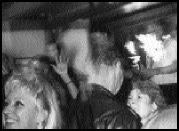Amid all the furor they’ve stirred up lately about view blockage, shadows, and visual impacts, monorail opponents (many of them light-rail fans) have neglected to mention a little-known fact about Sound Transit’s light-rail line: Roughly a third of the 14-mile starter system, according to Sound Transit spokesperson Lee Somerstein, will be elevated, some of it as much as 60 feet above the ground. Now, we’re hardly apologists for the “don’t block our views” argument—come on, people, we live in a city—but won’t light rail be just as opaque (and view-obstructing) as the 30-foot-high monorail? According to Somerstein, about half the line will be at street level; the remaining 20 percent, including the portion that runs through the Downtown Transit Tunnel, will be underground. . . .
You just can’t get enough of the monorail, can you? No, you can’t. Since we know how you feel, here’s this week’s monorail news update: Rise Above It All, the monorail campaign, says it has collected enough signatures—6,000, well over the required 3,700—to put its own monorail measure on the November ballot. That measure, unlike the one drafted by the City Council, would omit the monorail’s West-Seattle-to-Ballard route from the ballot title, instead referring vaguely to “the plan adopted by the Elevated Transportation Company.” Rise Above It All founder Peter Sherwin says the group had to move forward with its signature campaign to ensure that monorail opponents didn’t get their own competing measure on the ballot; thanks to a flaw in the legislation that funded the ETC, anyone with a clipboard and a pen can collect signatures and submit a proposal to the county. RAIA campaign manager Patrick Kylen says that from what he’s been told by attorneys for the county elections office, the first (and only the first) initiative to collect enough valid signatures will go onto the ballot; however, Kylen adds, “we’ve had some resistance from [the county] to putting that in writing.”
Meanwhile, Kylen says, the campaign has apparently convinced a majority of Seattle City Council members—including monorail convert Jan Drago, along with usual suspects Heidi Wills, Nick Licata, and Judy Nicastro—to forgo their own monorail measure, which the council had threatened to put on the ballot alongside Rise Above It All’s. “Once you have Jan, it’s a lot easier” to convince the rest of the council, Kylen says. If that’s true (council offices contacted before the ongoing two-week recess remained ambivalent ), it means that Rise Above It All’s measure won’t have to compete with the council’s almost identical proposal in November. But it also means the monorail ballot measure, finalized less than three weeks ago by the ETC, would move forward without further public comment or amendment. . . .
Ever feel like you’re being watched? If you happen to be down in Pioneer Square, you might just be. The Pioneer Square Community Association (PSCA), with the help of a grant from the South Downtown Foundation (set up by Paul Allen’s First and Goal to mitigate the effect of the Seahawks Stadium on nearby neighborhoods), plans to train three public surveillance cameras on the area. Because the money, around $20,000, is coming from a private foundation, the City Council won’t have to approve the proposal, says the PSCA’s executive director, Casey Jones. The goal, according to Jones, is to deter crime “in areas where criminal activity in public areas is pretty rampant,” like Occidental Park and the corner of Third and Yesler.
But will crime “prevention” mean invading the privacy of innocent citizens? Doug Honig, spokesperson for the American Civil Liberties Union of Washington, worries that by allowing the privately owned cameras to capture the everyday activities of innocent individuals, the government could start down the slope toward a 1984-style surveillance state. In Britain, where 2.5 million cameras peer at citizens from signposts, ceilings, and traffic lights, the friendly eye in the sky is damn near inescapable. “One estimate is that everybody in Britain is looked at by 300 cameras daily,” Honig says. “I hope we don’t end up having that kind of situation develop here.” Another question—who will have access to the footage?—concerns Honig. “Would it be used to identify demonstrators?” Honig wonders. Jones says the police department would probably be able to view the footage. But because the files are Web-based, not on videotape, Jones says they wouldn’t be stored for more than a week or two, preventing the creation of a permanent archive. Representatives from the SoDo Foundation did not return repeated calls for comment.
Erica C. Barnett









